Tidal Exchange






Gaze across the slough’s tidal wetlands and you will see lush habitat and amazing wildlife — harbor seals hauled out on muddy shores, shorebirds probing the mud for a wriggly meal, and Southern sea otters grooming their fur as they rest on pickleweed.
Land managers and conservation scientists at Elkhorn Slough are dedicated to conserving the richness, beauty, and productivity of this vital ecosystem. As part of the Reserve’s mission to study and protect these natural wonders, these researchers are working to monitor and restore a valuable, yet easily overlooked, resource linked inextricably to the health of the slough’s salt marshes — blue carbon.
Blue carbon refers to carbon dioxide (CO2 ) removed from the atmosphere by coastal or marine ecosystems. Tidal marshes are especially effective “carbon sinks” (systems that capture and store atmospheric CO2 ) because, as sea level rises, the marshes’ capacity to sequester carbon does, too.
Salt marshes occupy a very specific elevation relative to the tides—submerged too little, they dry out; too much, they drown. To remain in this ideal zone, marsh plants



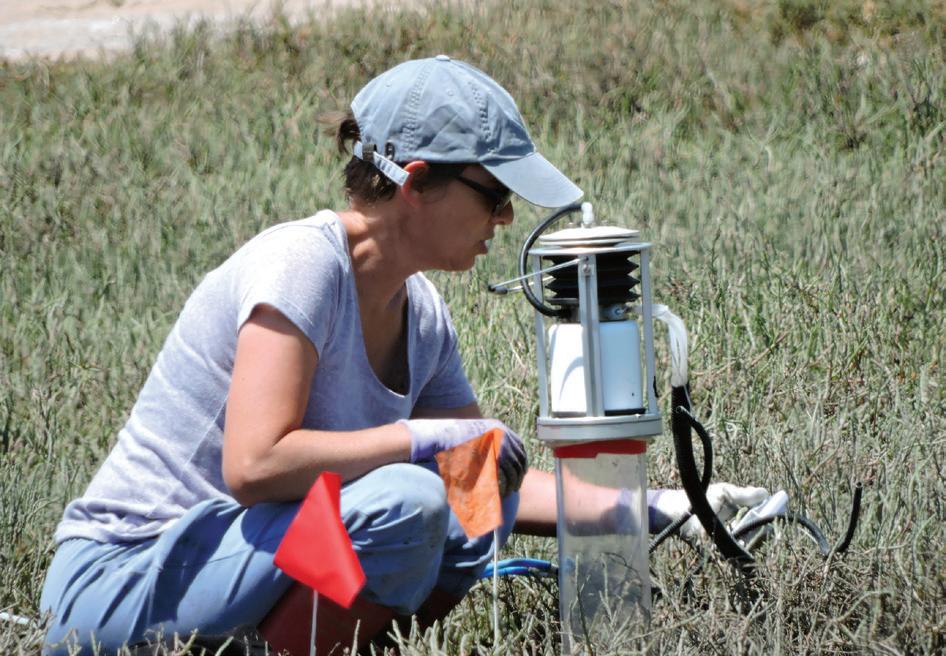


gradually grow to follow changes in sea level, burying past generations of vegetation and sediment along with captured carbon. Salty, low-oxygen conditions beneath the surface preserve these buried sediments indefi nitely, limiting the release of potent greenhouse gases (such as methane and nitrous oxide) that contribute even more significantly to climate change than CO2 .
Recent studies indicate that salt marshes are able to trap and store 10–15 times more atmospheric carbon than temperate forests, reaffi rming that these tidal wetlands are critically important to restore and protect.
Elkhorn Slough Foundation
Elkhorn Slough OtterCam Goes HD
Judith Connor
President
Anne Olsen
Vice President
C. Michael Pinto
Treasurer
Robert Hartmann
Secretary
Steven Webster
Past President
Ed Boutonnet
Terry Eckhardt
Sandy Hale
Kent Marshall
Anne Secker
Murry Schekman
Thomas Williams
Mary Wright
Mark Silberstein
Executive Director
The mission of the Elkhorn Slough Foundation is to conserve and restore Elkhorn Slough and its watershed.
We see Elkhorn Slough and its watershed protected forever— a working landscape, where people, farming, industry, and nature thrive together. As one of California’s last great coastal wetlands, Elkhorn Slough will remain a wellspring of life and a source of inspiration for generations to come
PO Box 267, Moss Landing California 95039
tel: (831) 728-5939
fax: (831) 728-7031
www.elkhornslough.org
Scott Nichols, Editor
Slough Foundation
Since we began streaming live video of our estuary’s sea otters in 2012, the Elkhorn Slough OtterCam has attracted the attention of scientists, educators, and otter enthusiasts near and far.
At its core, the OtterCam is a research and education tool. Researchers can observe previously unseen behaviors of Southern sea otters on the pickleweed and in the tidal channels, unobtrusively monitor the activities of moms and pups, and identify tagged otters that are part of a collaborative three-year otter study. By visiting elkhornslough.org/ottercam, classrooms and viewers from around the world get an immediate and intimate look at the lives of these charismatic marine mammals, learning about wild otter behaviors and connecting with the threatened species.
For more than two years, the Elkhorn Slough OtterCam has shared a big picture view of the slough’s otters, with just one small devil in the details — bandwidth requirements limited our original feed to standard definition video, sacrificing a little image clarity for the ability to stream smoothly and reliably.
But now — thanks to grants from PBS and the Acacia Foundation, and support from a member-sponsored crowd-funding campaign — the OtterCam is redefining itself with not just one, but two new high-definition cameras! The crisp detail and great zoom capabilities are providing clear otter identification and viewing.
If you haven’t visited the OtterCam in a while, there’s no time like the present. The Elkhorn Slough OtterCam will be highlighted on PBS as part of Big Blue Live, “a live television event showcasing marine life along America’s West Coast,” which airs August 31–September 2.
We’re thrilled that Elkhorn Slough is boosting research and international awareness of these iconic central coast critters. n
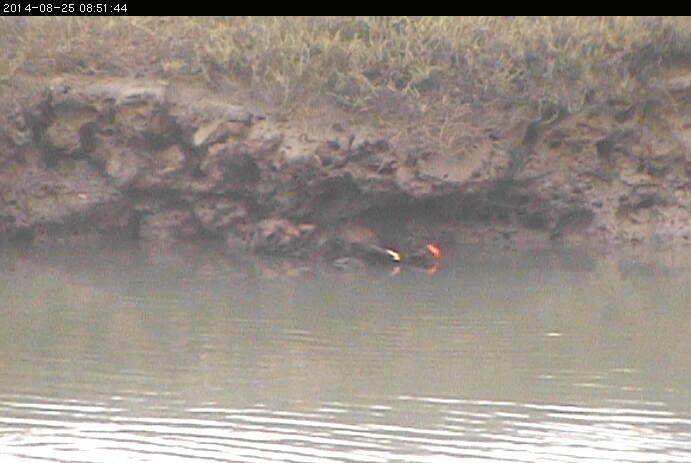


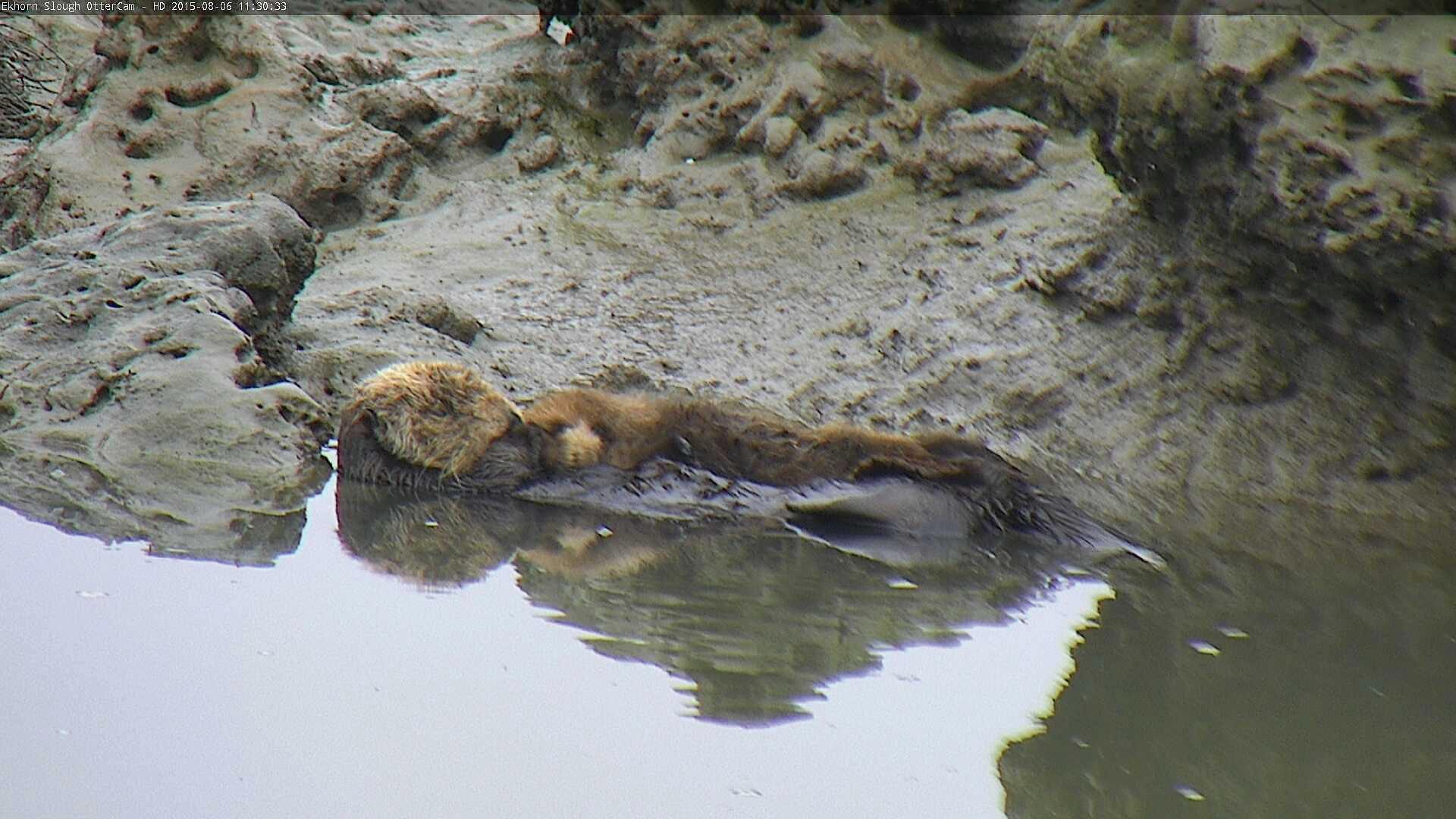
The high-definition OtterCam provides greater image clarity for viewers and researchers to observe sea otter behavior. The new camera was made possible in part by generous grants from PBS and the Acacia Foundation.
As an estuary — a place where freshwater from land meets the sea — the Elkhorn Slough fulfi lls a variety of interconnected ecological roles, such as buffering against floods and erosion, fi ltering runoff from the watershed, and providing habitat for plants and wildlife.
In a healthy estuary with natural inputs, fluctuating conditions usually remain within a range that sustains native species. Estuaries have an amazing ability to cushion against events that cause extreme change. But even the most resilient ecosystem can be overwhelmed when the balance is upset by human influences, such as excessive nutrient loads carried by polluted runoff.



Stress on coastal ecosystems is the subject of a recent study published in Proceedings of the National Academy of Sciences by Elkhorn Slough researcher Brent Hughes, ESNERR’s Monique Fountain, and other colleagues. The team looked at how high nutrient loads in Elkhorn Slough impact fish nurseries in the slough. Thanks to reliable water quality measurements taken at Elkhorn Slough since 1970, the researchers have been able to analyze how fish abundance and diversity have been correlated with water quality conditions throughout the past four decades.
When water from the uplands flows into the Elkhorn Slough from creeks, groundwater and drainage ditches, it carries substances from the surrounding landscape. Earlier studies by slough researchers have shown that water quality in the slough has been adversely affected by excessive nutrients entering the slough from agricultural runoff.
Just as we require oxygen in the air we breathe, fish and invertebrates need dissolved oxygen in the waters they “breathe”. The researchers found that parts of the estuaries that consistently experience low levels of dissolved oxygen have dramatically reduced fish diversity. In addition to

identifying this pattern of distribution, the team also observed changes over time — years with lower oxygen produced fewer fish than years with higher oxygen. In good years, flatfish were abundant all the way up the estuary to Kirby Park, but in bad years, only the lower estuary supported the growth of young flatfish.
The researchers also found that a good fish year at Elkhorn Slough was followed by a good catch of flatfish offshore in the Monterey Bay, but years of low oxygen led to a reduced catch. Th is is a stunning result, showing that improving water quality in the estuary can have ecological and economic benefits for the entire Monterey Bay.
The study indicates that reducing nutrient runoff from the uplands can directly benefit fish nurseries in the estuary, thus indirectly improving offshore fisheries. In other words: how we protect and steward the land ultimately affects water quality for people, plants, and animals at every level of the watershed — from the uplands to the sea.
ESF protects nearly 4,000 acres of land surrounding the slough. Previous studies have shown reduced nutrient loading and improved water quality near restored Foundation lands. Our restoration of more than 2,000 acres and ongoing stewardship of conservation lands plays a critical role in improving the slough’s health. n
Calling all photographers! ere’s still time to submit your winning images to the Elkhorn Slough 2016 Calendar contest. We’re accepting entries through September 30, 2015. For more information, visit www.elkhornslough.org. n


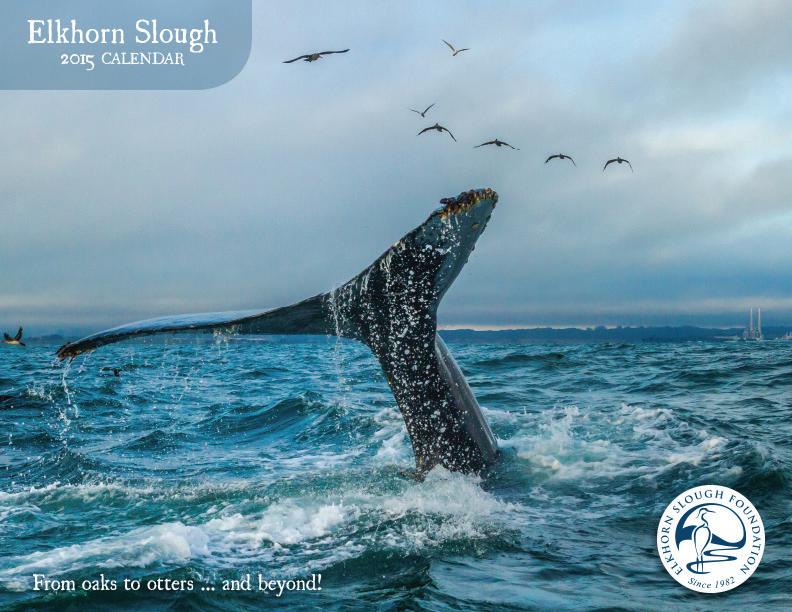

(continued from cover)
Since 1870, nearly 50% of Elkhorn Slough’s historic tidal marshes have been diked and drained to create pasture and farmland resulting in the marsh subsiding as much as six feet below historic levels. Th is reduces the marsh’s health, resiliency, and limits its function as a carbon sink.
The Tidal Marsh Restoration Project is restoring approximately 50 acres of salt marsh by adding sediment to raise base elevations in a portion of the Reserve that subsided due to diking, to levels that will again support tidal marsh.



Graduate student Kat

and
Research Coordinator Kerstin Wasson use the gas analyzer to sample greenhouse gases — including carbon dioxide, nitrous oxide, methane, ammonia, and water vapor — exchanged between the air, plants, and soil contained in the chamber beneath the field probe. (left,
“The project not only expands salt marsh acreage, it offers researchers the opportunity to precisely measure how restoration affects the ecosystem’s ability to capture greenhouse gases,” notes ESNERR Tidal Wetland Program Director Monique Fountain, who is heading up the restoration. “What we learn will help make future

By fi ltering runoff and limiting soil erosion from storms, healthy upland habitat can safeguard the wellbeing of adjacent marshlands. Natural ecosystems consist of a mosaic of interconnected habitats, and the Tidal Marsh Restoration Project is aiming to restore a complete coastal ecosystem, from channels to marshes to coastal prairie on the Reserve. The dominant marsh plant at this estuary, pickleweed, disperses well by seed and is expected to colonize on its own at the restoration site, once the right elevation is achieved.
However, in the marsh-upland transition, or ecotone, a variety of high marsh plants and salt-tolerant prairie species will be planted. Above that, 10 acres of native grassland will be restored on what was formerly farmland.
Planting a landscape of this scale with grasses native to the watershed requires advance planning, significant investments of time and labor, and ample quantities of locally sourced seed. So, with the future in mind, Reserve and Foundation land stewards have expanded the native
grass farm at ESF’s Iniguez property, planting more than 20,000 seedlings.
The seeds for these grasses — including blue wild rye, California brome, purple needlegrass, California oat grass, tufted hair grass, and meadow barley — were collected from around the Elkhorn Slough watershed, and were propagated at the Reserve greenhouse by restoration specialists and volunteers. Planting these seeds also offered a hands-on learning experience for students in our education and outreach programs.
The grasses are beginning to grow strong and tall. We will harvest seed over the next few years, allowing us to restore grassland habitat at the Tidal Marsh Restoration Project, and on conserved ESF lands throughout the watershed. n


coastal marsh restoration projects more successful and sustainable.”
Th roughout the restoration efforts, these researchers will continue to collect data on how the salt marshes work to capture CO2 and other greenhouse gases, what quantities of other greenhouse gases are generated in the process, and to monitor the additional benefits and challenges of salt marsh restoration.
Led by Beth Watson (who, five years ago, began analyzing the effects of climate change on the marshes of Elkhorn Slough as a Reserve researcher, and is now Assistant Professor of Wetlands Science at Drexel University) and ESNERR Research Coordinator Kerstin Wasson, the research team has been taking sediment cores, tracking carbon burial rates, and measuring greenhouse gas fluctuation in mudflats, marsh, and adjacent grassland areas. Taken together, these data can then be used to extrapolate the net effect on greenhouse gases in the larger area as mudflats are restored to marshes.
“There have been many ‘back-of-the-envelope’ calculations of potential climate change benefits of marsh restoration,” says Kerstin. “But we’re excited to learn firsthand what the real benefits are, by measuring carbon storage and burial rates, as well as gas emissions at the site before and after restoration.”
The blue carbon research and salt marsh restoration is partially funded by a $3 million grant from the California

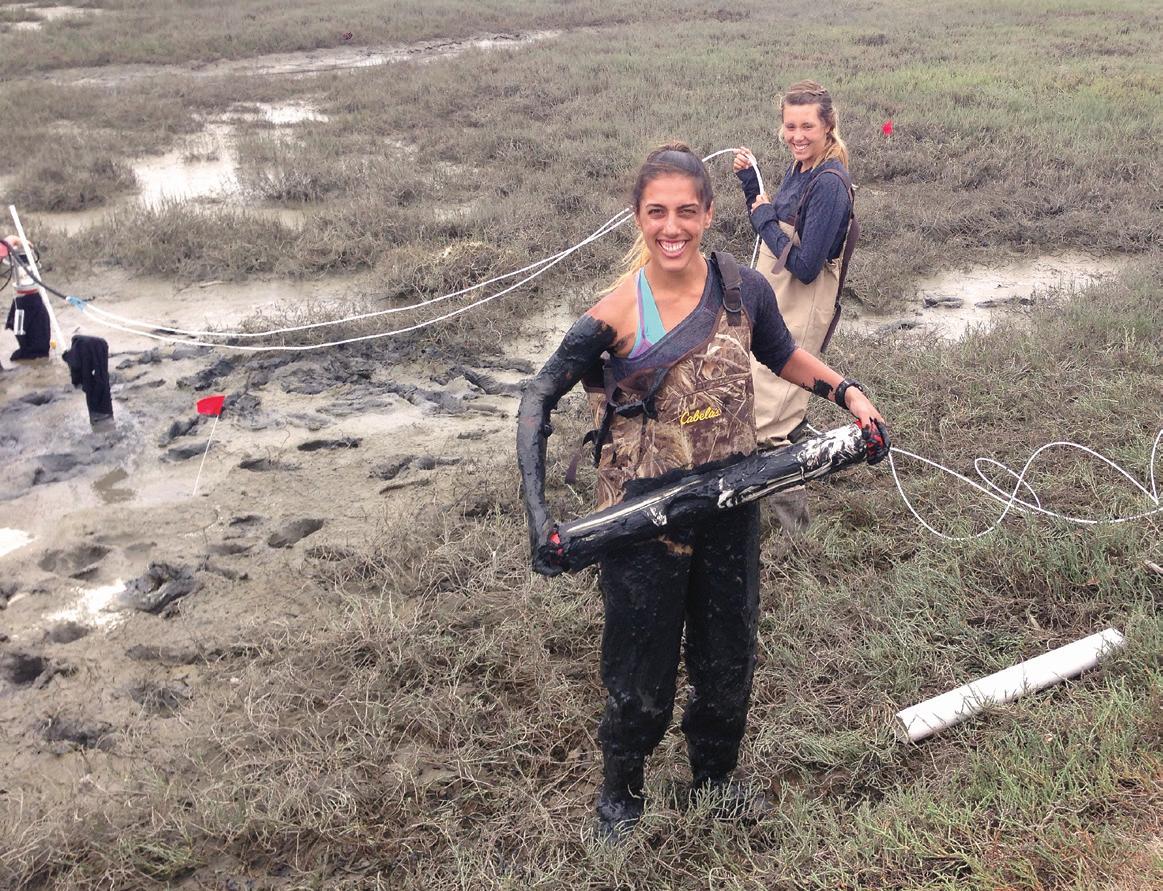



Started at the Reserve greenhouse, the seedlings were planted at the native grass farm on ESF’s Iniguez property using a mechanical transplanter (left), which helped the restoration team efficiently plant the seedlings in rows (above) that simplify drip irrigation and weed control.
Department of Fish and Wildlife to restore wetlands that sequester greenhouse gases, serve as habitat for Southern sea otters and other wildlife, and provide a variety of other ecological benefits.
If you are interested in learning more about climate research, salt marsh sustainability, or the Tidal Marsh Restoration Project, you can fi nd additional information on our website, www.elkhornslough.org. n

For a second year, the Reserve has been a host institution for the Research Experiences for Undergraduates (REU) internship program in ocean sciences, in collaboration with California State University Monterey Bay (CSUMB) and the National Science Foundation.
This summer, we welcomed interns Katie Gregory and Catrin Wendt, who gained hands-on experience and assisted with essential research tasks, such as observing sea otters, surveying crab populations, and monitoring water quality. The interns also conducted independent research projects under the guidance of ESNERR Estuarine Ecologist Rikke Jeppesen.
“Rikke is always positive and makes me feel capable in the research setting,” says Katie. “She has been my mentor and my biggest support system on this side of the country.”
A student of marine science at State University of New York at Stony Brook, Katie Gregory focused her independent
(Continued on page 6)
Do you remember the excitement of your first visit to the Elkhorn Slough? Perhaps you recall the anxious exhilaration of launching a kayak, or the joy of watching crabs skitter across the marsh into muddy hiding places, or the tiny marvels of life in a drop of water beneath the microscope. These formative experiences inspire us to appreciate and protect our wild places.

The ESF Conservation Education Scholarship for The Les Strnad Award was established to offer local students a chance to encounter the wonders of Elkhorn Slough — a lasting tribute to Les and his work to protect the slough for future generations. Les helped establish the Elkhorn Slough Reserve; he also co-founded Camp SEA Lab, an environmental education program that fosters excitement, scientific understanding, and stewardship of our coasts and ocean for youth, families and teachers.
This year, ESF’s Les Strnad Award supported thirteen day-campers (most of whom had never visited the slough) to attend Camp SEA Lab’s “Elkhorn Slough and You!” week-long summer program — hiking, kayaking, restoring habitat, and exploring science through fun and games. The students are all residents of Community Housing Improvement Systems & Planning Association (CHISPA) affordable housing in East Salinas and are part of a thriving new partnership between ESF, Camp SEA Lab, and CHISPA — bringing underserved youth to this amazing natural area.
At the collegiate level, ESF also supports the James Rote Scholarship for Coastal Science and Policy, named in memory of the late educator, scientist, and policy advisor. Dr. Rote was one of the chief architects of the plan to



ESF’s Les Strnad Award helped thirteen day-campers (above) attend Camp SEA Lab’s “Elkhorn Slough and You!” week-long summer program. The campers explored the slough on foot, by kayak, and through the microscope. (left, photos
create the Monterey Bay National Marine Sanctuary, and a founding faculty member of California State University Monterey Bay (CSUMB).
Earlier this year, the Foundation awarded the James Rote Scholarship to support CSUMB graduate student Michael Esgro’s research on the role of Marine Protected Areas (MPAs) in supporting both economically and ecologically important species.
If you are interested in contributing toward one or both of these endowed scholarships, simply indicate which fund you wish to support when making your gift.
Thank you for supporting the future of science, while honoring two dedicated individuals who worked tirelessly to protect the natural wonders of the Monterey Bay. n
(Continued from page 5)

research on relationships between sea otter predation and the distribution of native and non-native crabs in the estuary.
Catrin Wendt studies marine science at CSUMB, and is interested in the ecology of rocky intertidal and marine habitats. For her independent research, Catrin analyzed relationships between water quality data and the distribution of invasive European green crabs.
“Long-term monitoring is labor-intensive and often undervalued,” says Rikke. “So when interns like Catrin and Katie can use our long-term data to address specific short-term research questions, it’s highly valuable.” n


Kerstin Wasson, PhD, ESNERR Research Coordinator



On any given day, there are dozens of research projects in progress at Elkhorn Slough, on topics ranging from geology to hydrology to chemistry to biology to social science. The detectives unraveling the mysteries of the estuary include Elkhorn Slough Reserve staff, volunteers, interns, and professors and scientists from local universities and organizations. Moreover, bringing the passion and curiosity of new scientists, graduate students dedicate considerable time and effort each year to slough research. Their investigations comprise the gold standard of knowledge about Elkhorn Slough — knowledge that helps us to better conserve and manage the estuary. In turn, graduate students gain insight into threatened habitat and biodiversity, life-shaping experiences, and connections with organizations dedicated to conservation science.
In the late 1920s, the pioneering study of Elkhorn Slough’s natural history was conducted by George MacGinitie, while a graduate student at Stanford. His thesis work, one of the first studies of any California estuary, put Elkhorn Slough on the map and launched his career. MacGinitie later became director of Caltech’s Kerckhoff Marine Laboratory and, with his wife Nettie, studied marine invertebrates along the Pacific coast.
Many other graduate students have since followed suit, conducting research at the slough that launched their scientific careers.
For instance, Jeb Byers designed elegant experiments to determine why the invasive mudsnail Batillaria has been able to out-compete its native counterpart Cerithidea at many Pacific estuaries, including Elkhorn Slough. When I first met Jeb in the late 1990s, he was standing deep in sticky mud in the mudflat just north of Hummingbird Island on the Reserve. Today he is a leading invasion biologist and a tenured professor at the University of Georgia — geographically distant but no doubt shaped
by his experiences with the all too prominent invaders in Elkhorn’s mud.
While some students took the lessons they learned from Elkhorn Slough to faraway places, many others stayed closer to home. For example, two Moss Landing Marine Laboratory graduate students of the 1980s, Jim Barry and Mary Yoklavich, were focused on detecting patterns in the diversity of the slough’s fish communities through space and time. Jim is now a senior scientist at the Monterey Bay Aquarium Research Institute, and Mary leads the Habitat Ecology team at the National Marine Fisheries Laboratory in Santa Cruz.


Fortunately for us, many graduate students have remained truly local, joining the Elkhorn Slough Reserve’s permanent staff. Stewardship Coordinator Andrea Woolfolk (now responsible for conservation and restoration projects throughout the Reserve) examined the effects of human and cattle trampling on the slough's salt marshes while a graduate student at Moss Landing Marine Laboratories.

Rikke Jeppesen, while a student at UC Santa Cruz, investigated invasive European green crabs, discovering they are doing quite poorly at Elkhorn Slough compared to their native northern European coast. Rikke now serves as our staff Estuarine Ecologist, linking water quality to ecological impacts.
Charlie Endris graduated from Moss Landing Marine Laboratories, where he used laser scanning to map erosion in the slough’s mudflats — and he continues to track habitat changes in the Elkhorn Slough as our Geographic Information Systems (GIS) specialist.

Whether they stay near or roam far, graduate students have taught us much of what we know about the estuary and, in turn, the slough has changed them forever. Elkhorn Slough is a nursery not only for fish and invertebrates, but for scientists as well. n


P.O. Box 267
Moss Landing, CA 95039
The Elkhorn Slough Reserve is open Wednesday through Sunday, 9 am to 5 pm. Join us for docent-led tours every Saturday and Sunday at 0 am and pm.
SAVE THE DATES:
September 26: Reserve Open House & Native Plant Fair
October 24: ESF Animal Tracking Outing
Watch for details about these, and other upcoming events at our website, www.elkhornslough.org.
We have some great fall events on the horizon, including birding walks, kayaking tours, art workshops … and more!

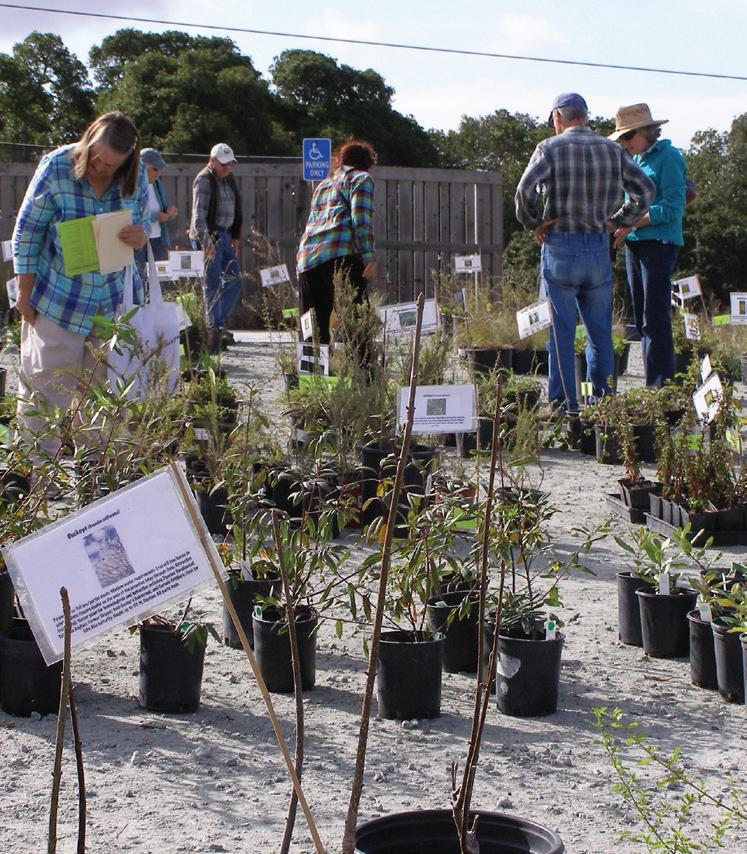
Visit ElkhornSlough.org and follow us on Facebook & Twitter for news and updates on upcoming events & more!



